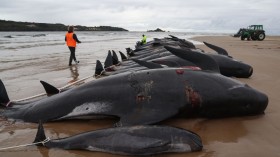The analysis of a new fossil of an ancient walrus throws doubt on earlier claims that the animal was once a "killer", preying on marine mammals, say scientists.
Fossils of the extinct walrus species named Pelagiarctos, which lived between 15 and 18 million years ago during the middle Miocene period, were originally found in the 1980s. The large jaw bone and sharp pointed cusps of the teeth of a prehistoric walrus specimen suggested that the animal was a deadly killer feeding on marine mammals rather than just fish - a typical diet of modern walruses.
But a recent study on a new fossil specimen has cast doubt on the "killer" walrus claim. Researcher Robert Boessenecker from University of Otago, New Zealand, and Morgan Churchill from the University of Wyoming analyzed a more complete specimen of the walrus, including its lower jaw with teeth.
They found that the teeth of the fossil were not sharp enough to feed on large prey. Instead, it possessed a primitively retained tooth shape, suggesting that the animal lacked adaptations for being a "killer walrus" and was more of a fish-eater.
"This new find indicates that this enigmatic walrus would have appeared similar in life to modern sea lions, with a deep snout and large canines," Boessenecker said in a statement.
The researchers then estimated the body size of the Pelagiarctos and found that its size was similar to that of the modern-day male sea lions, weighing about 770 lbs. Modern-day animals that belong to the family of pinnipeds including seals, sea lions and walruses, have large body sizes, but they tend to have diets rich in fish. This suggests that the body size of Pelagiarctos (similar to sea lions) doesn't make the ancient animal an apex predator.
Further analysis of the evolutionary relationships of Pelagiarctos showed that the animal was an early sea lion-like walrus that was closely related to another sea lion-like walrus, Imagotaria downsi, which is also from California.
The findings of the study are published in the online journal of PLOS ONE.
© 2024 NatureWorldNews.com All rights reserved. Do not reproduce without permission.





